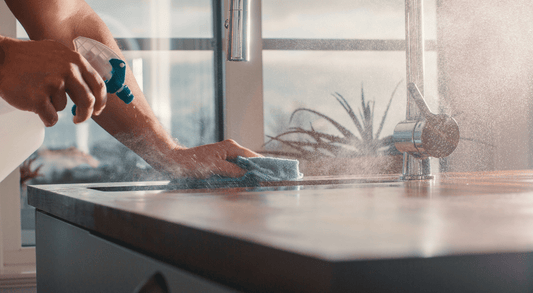Hot process soap making is very forgiving, there is less that can go wrong than with cold process soap. It makes a rustic looking bar with a wonderful homemade appearance.
This basic hot process soap recipe uses just coconut oil, and it makes a super hard bar of soap that lathers well and lasts a long time.
Coconut oil can be a little drying in soap but this is easily counteracted with a higher superfat. In this we are superfatting at 20%, read more about how to superfat soap
Equipment
- Gloves
- Goggles
- Weighing scale
- Hand blender.
- 3.5 litre slow cooker
- A 1200g silicone mould or an ice cream tub lined with greaseproof paper. (Check out our range of silicone soap moulds)
- 2x 1 litre plastic or stainless steel jugs.
- Silicone or stainless steel spatula.
- Digital or jam thermometer.
Ingredients
900g coconut oil
297g water
132g sodium hydroxide
Method
1. Weigh and mix your ingredients

- Weigh your cold water into one of your jugs. Place to one side
- Safety gear on – gloves and goggles!
- Weigh your sodium hydroxide into the other jug.
- Pour your sodium hydroxide into your water jug, not the other way around. Make sure your workspace has decent ventilation. Stir for around 10 to 15 seconds until completely dissolved with your spatula.
- Place safely to one side. It will be too hot to use at the moment. We need this to be quite cool, ideally around room temperature so to save time you could stand the jug in an ice bath to speed up the process.
- Switch your slow cooker on high and weigh your 900g coconut oil into it to melt.
2. Check your temperatures

- When your coconut oil has melted, check your temperatures. Hot process soap can boil over like boiling milk if it gets too hot when you are making it. You need your coconut oil to be below 65°C and your lye solution to be below 26°C.
- When you are happy with your temperatures pour your sodium hydroxide solution into your coconut oil in your slow cooker.
3. Blend until trace

- Stir gently with your hand blender and then blend until it reaches a light to medium trace. This means you have a batter that has thickened up a little and when you drizzle a little of it across the top of the jug of batter it sits on top for a moment. Hot process soap making is very forgiving, if you blend too much it will not matter.
- See picture above for a medium to heavy trace.
4. Cook for 20 to 30 minutes

- Cook on low in your slow cooker. Your soap will go through different stages, a solid waxy substance and then begin to soften and gel until it resembles a thick mashed potato texture with a glossy, Vaseline like sheen. Do not overcook, if in doubt you can check your soap with a pH strip. You are looking for a pH of around 10.
- Take a look at the photo above, that's what our soap looked like when it was done.
- Remove your ceramic cooker dish from the cooker and then stir and cool your soap until it is below 80°C.
5. Mould your soap

- Scoop into your mould and tap on the worktop to fill air pockets.
- Try to smooth and level the surface as much as you can. Don't worry if it is still a little rough, this creates bars with a lovely natural look. You can always trim it off if you don't like it.
6. Cut and cure

- Coconut oil soap sets up hard and fast. You will need to cut your soap loaf while it is still warm - usually within 2 or 3 hours.
- Make sure you wear gloves, your soap is not skin safe yet.
- Leave your cut bars to cure for 4 weeks.
Here's our finished bars!

Continue Reading
Now that you've learnt how to make hot process soap, why not take your natural beauty routine to the next level? Read on to lean how to make other natural products.
- Learn how to make body butter with our body butter recipe
- Learn about melt and pour soap making with our Tea tree soap recipe
- Learn more about carrier oils with our Ultimate list of carrier oils
- Learn about cold process soap making with our lavender cold process soap recipe



